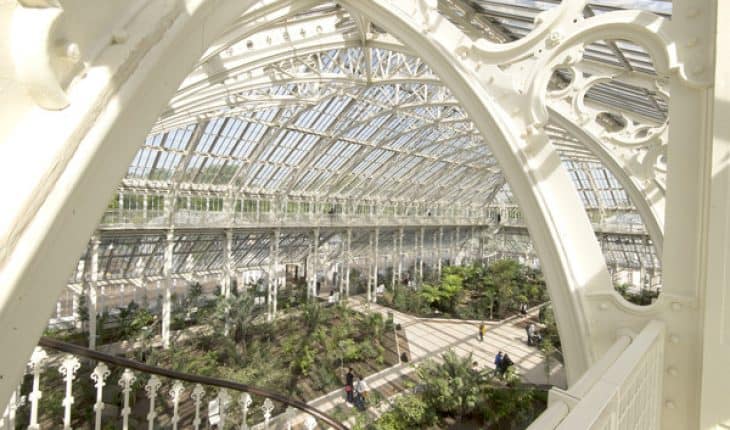After the biggest restoration project in its entire 175 year history, Kew Gardens has re- opened the doors of its spectacular Temperate House, restored to its dazzling Victorian glory, revealing 10,000 exotic plants. Many of these rare plants are currently being researched by Kew’s scientists to develop new drugs to treat serious illnesses such as Ebola, cancer, anti-inflammatories, asthma and cardiovascular disease.
Richard Barley, director of horticulture at RBG Kew, says: “Over the past few months, I have watched as some of the world’s rarest plants finally reach their home. And what a home it will be – a glistening cathedral, the new glass allowing the sun to stream in, the ironwork restored to its glossy best.
The world’s largest Victorian glasshouse will once again be home – as it had been since its birth in 1863 – to some of the world’s rarest and most threatened plants. In contrast to their sumptuous, romantic surroundings, these plants present a stark message; despite being the foundation of pretty much all life on earth, we are allowing them to fall prey to a variety of threats.
The world’s largest Victorian glasshouse will once again be home – as it had been since its birth in 1863 – to some of the world’s rarest and most threatened plants. In contrast to their sumptuous, romantic surroundings, these plants present a stark message; despite being the foundation of pretty much all life on earth, we are allowing them to fall prey to a variety of threats.
Here they are safe from peril. When the last plant of a particular species dies out, what might it take with it? A new cure for Cancer? Or Ebola? The Temperate House will tell the stories of the plants that Kew has rescued, and the journeys they have taken to reach the sanctuary of their new home. Speaking about Kew to the BBC Sir David Attenborough said: ‘Kew does all sorts of things that nowhere else does. If you want to identify something, this is the ultimate authority worldwide’.
Visitors to the new Temperate House can expect to see plants from areas such as the Mediterranean, Africa, Australia, New Zealand, South and Central America, Asia and the Pacific Islands, as well as learn about their journey to Kew Gardens.
Entering the glasshouse, visitors will embark on a round-the-world adventure. They might find themselves in Mauritius, where they will see Dombeya mauritiana, a tree that was thought to be extinct in the wild until Kew’s renowned ‘plant messiah’ Carlos Magdalena found one growing in the Mauritian highlands. After many trials and tribulations (including forming a human ladder to reach the lowest branch!), Carlos was able to gather and return with cuttings, and Kew is now the only place in the world with this tree in cultivation.
Around the corner, from the mountains of Nepal, visitors will encounter the Taxus wallichiana, exploited for the Taxol market (a chemotherapy drug) and now subject to a clonal propagation program to help conserve it in the wild.
Other plant highlights in the Temperate House include Lessertia frutescens from Southern Africa, regarded by scientists as one of the most important and multi-purpose of the medicinal plants in Southern Africa. It has enjoyed a long history of use by all cultures in the region because of its efficacy as a safe tonic for a diverse range of health conditions including symptoms associated with AIDS and cancer.
Other plant highlights in the Temperate House include Lessertia frutescens from Southern Africa, regarded by scientists as one of the most important and multi-purpose of the medicinal plants in Southern Africa. It has enjoyed a long history of use by all cultures in the region because of its efficacy as a safe tonic for a diverse range of health conditions including symptoms associated with AIDS and cancer.
Of particular interest for scientists and tea drinkers alike is Camellia sinensis, otherwise known as tea, the plant from which the nation’s favourite beverage is made and is valued for its stimulant properties and health benefits. Aside from water, tea is the most commonly drunk beverage in the world, over three million tonnes of C. sinensis are grown annually. In Britain alone we drink 165 million cups of tea a day. That’s 62 billion cups a year!
Another important plant, with healing properties is the Nepal yam, Dioscorea deltoidea, which is native to Himalayan forests, from Kashmir and Punjab eastwards to Nepal and China. It produces inedible rhizomes or roots that branch horizontally underground. This rhizome is rich in a steroid that can be used to create vital drugs including anti-inflammatories and asthma inhalers.
Used to make cancer drugs, Taxus wallicihiana is a conifer native to the Himalayas. It provides both extremely durable building materials and contains chemical compounds for the vital anti-cancer drug, paclitaxel, for which it has been illegally exploited for in recent years. A 90% decline has been recorded in major parts of its range by the International Union for Conservation of Nature (IUCN).
Also a treasure, Ensete ventricosum, a plant in the banana family that grows in the wild in eastern, central, and southern Africa. It has been cultivated for thousands of years, exclusively in Ethiopia, becoming a staple crop for 20 million people. The crop is particularly resilient and has great potential for improving food security in Ethiopia and other parts of Africa, especially in areas affected by drought. Kew scientists are carrying out research to find out more about the biology of the crop and how could be a possible food of the future.
At the start of the restoration of the Temperate House, 500 plants were removed from the glasshouse and housed in a temporary nursery behind the scenes, to be propagated and nurtured by Kew’s leading horticulturists. During the past year, 10,000 plants have been carefully re-planted into the newly restored structure.
The glasshouse is now home to a world of luscious plant life and sumptuous, romantic beauty, but it also reveals an urgent message, that plants are the foundation of all life on earth, and they are in trouble. With the global challenges of climate change, biodiversity loss and food security, these incredible plant collections, resplendent in their newly renovated home, will highlight Kew’s role in safeguarding rare and threatened plants from extinction
- People’s Choice Victory for Down’s Syndrome Scotland Garden at Chelsea 2025 - 28th May 2025
- Cadogan: A Chelsea Family By Tamsin Perrett - 3rd May 2025
- Dream Worlds a new exhibition in Cambridge - 14th December 2024







